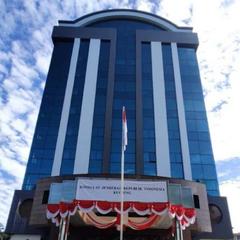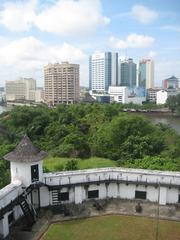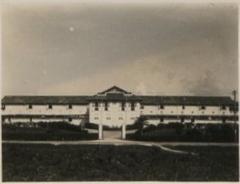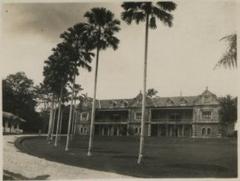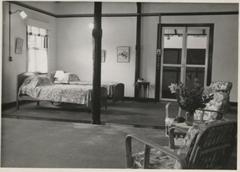Visiting Hours and Tickets for Siew San Teng Tua Pek Kong Temple in Kuching
Publication Date: 25/07/2024
Introduction to Siew San Teng Tua Pek Kong Temple
The Tua Pek Kong Temple, officially known as 寿山亭大伯公庙, is a historic and culturally significant Chinese temple located in Kuching, Malaysia. This sacred site, often referred to as the Siew San Teng Tua Pek Kong Temple, is not only a place of worship but also a treasure trove of history and culture that dates back to 1839. Over the years, it has survived numerous adversities, including the Great Fire of Kuching in 1884 and the Japanese invasion during World War II, and has undergone several significant renovations (Wikipedia).
This comprehensive guide aims to provide visitors with essential information on the temple’s visiting hours, admission fees, dress code, and travel tips. Additionally, it delves into the temple’s rich history, cultural significance, and nearby attractions, ensuring an enriching and respectful visit. Whether you are a history buff, a cultural enthusiast, or simply seeking a serene place to visit, the Tua Pek Kong Temple offers a unique glimpse into Kuching’s vibrant heritage.
Table of Contents
- Introduction
- History of Tua Pek Kong Temple
- Visitor Information
- Cultural and Historical Significance
- Nearby Attractions
- Safety Tips
- Local Cuisine
- Souvenirs and Shopping
- Transportation
- FAQ
- Conclusion
History of Tua Pek Kong Temple
Early Establishment and Development
The 寿山亭大伯公庙, also known as Tua Pek Kong Temple, is one of the oldest and most significant Chinese temples in Kuching, Malaysia. The temple’s origins date back to 1839, when it was initially a modest wooden structure located at the foot of a hill (Wikipedia). The first major reconstruction took place in 1856, transforming it into a more durable structure with reinforced wooden walls mixed with clay, lime, and sand.
Major Reconstructions
Throughout the 19th century, the temple underwent several significant renovations. In 1863, the roof tiles and some brick walls were replaced. By 1880, with the introduction of cement, the temple’s walls were converted to brick, giving it the traditional red walls and green tiles characteristic of Chinese temples (Wikipedia).
Survival Through Adversity
The temple has withstood numerous adversities over the years. It survived the Great Fire of Kuching in 1884, which devastated many surrounding buildings, and remained intact during the Japanese invasion in World War II, despite heavy bombing in the area (Wikipedia). These events have contributed to the temple’s reputation as a resilient and sacred site.
Mid-20th Century Renovations
By the mid-20th century, the temple required further repairs due to structural wear and termite damage. In 1964, a significant restoration project was initiated under the leadership of the temple’s caretaker, Ho Ah Chuan, with the support of local community leaders. The restoration was completed in 1965 and marked by a traditional “raising the beam” ceremony (Wikipedia).
21st Century Restoration
Entering the 21st century, the temple faced new challenges, including roof leaks and general wear and tear. In 2007, the Kuching Chinese Charitable Trust Committee, led by Chou Chi Ming, decided to undertake another major restoration project. The temple was officially reopened in September 2008 after extensive repairs (Wikipedia). The restoration included modernizing the facilities while preserving the temple’s historical and cultural integrity.
Visitor Information
Visiting Hours and Tickets
The Tua Pek Kong Temple is open daily from 7:00 AM to 6:00 PM. Admission is free, but donations are welcome to help maintain the temple.
Travel Tips
- Best Time to Visit: Early morning or late afternoon to avoid the heat and crowds.
- Dress Code: Modest attire is recommended out of respect for the sacred site.
- Photography: Allowed, but be respectful of worshippers.
Cultural and Historical Significance
The Tua Pek Kong Temple holds immense cultural and historical significance for the Chinese community in Kuching. It is managed by a trust committee comprising representatives from various Chinese dialect groups, including Hokkien, Teochew, Hainan, and Cantonese communities. This inclusive management structure has helped the temple become a central place of worship for people of diverse Chinese backgrounds (Wikipedia).
Feng Shui and Local Legends
The temple’s location was chosen based on feng shui principles, believed to bring peace, harmony, and prosperity to the local Chinese community. According to local legends, the temple’s feng shui was so potent that the Brooke dynasty, which ruled Sarawak, sought its advice for governance.
Nearby Attractions
- Kuching Waterfront: A scenic promenade along the Sarawak River, perfect for a leisurely stroll.
- Sarawak Museum: Offers a deep dive into the region’s history and culture.
- Main Bazaar: Ideal for shopping for local handicrafts and souvenirs.
Safety Tips
While Kuching is generally safe for tourists, it is always wise to take basic precautions:
- Personal Belongings: Keep an eye on your belongings and avoid carrying large amounts of cash.
- Hydration and Sun Protection: The tropical climate can be hot and humid, so carry water, wear sunscreen, and use a hat or umbrella for sun protection.
- Emergency Contacts: Familiarize yourself with local emergency numbers and the location of the nearest hospital or clinic.
Local Cuisine
After visiting the temple, take the opportunity to explore Kuching’s vibrant food scene. The city is known for its diverse culinary offerings, including:
- Sarawak Laksa: A spicy noodle soup that is a must-try for visitors.
- Kolo Mee: A popular local dish consisting of dry noodles tossed in a light sauce and topped with minced pork or beef.
- Kek Lapis Sarawak: A colorful layered cake that makes for a delightful dessert or souvenir.
Souvenirs and Shopping
The temple vicinity has several stalls and shops where you can purchase souvenirs, religious items, and local handicrafts. Popular items include:
- Incense and Prayer Beads: These make meaningful souvenirs and are often used in temple rituals.
- Local Handicrafts: Look for traditional Sarawakian crafts such as woven baskets, beadwork, and textiles.
- Food Items: Sarawak pepper, local snacks, and Kek Lapis Sarawak are popular choices for edible souvenirs.
Transportation
The Siew San Teng Temple is easily accessible by various modes of transportation:
- Walking: If you are staying in the city center, the temple is within walking distance of many hotels and attractions.
- Public Transport: Local buses and taxis are readily available. Ride-hailing services like Grab are also a convenient option.
- Car Rentals: If you prefer to explore at your own pace, car rentals are available in Kuching. Ensure you have a valid international driving permit if you plan to drive.
FAQ
Q: What are the visiting hours for Tua Pek Kong Temple? A: The temple is open daily from 7:00 AM to 6:00 PM.
Q: Is there an entrance fee? A: No, admission is free, but donations are appreciated.
Q: Are there any dress code requirements? A: Yes, modest attire is recommended.
Q: Can I take photos inside Tua Pek Kong Temple? A: Photography is generally allowed, but avoid using flash and adhere to any signs indicating that photography is not permitted.
Conclusion
Tua Pek Kong Temple is not just a place of worship but a repository of history and culture in Kuching. Whether you are interested in its historical significance, architectural beauty, or spiritual atmosphere, the temple offers a unique experience. Plan your visit to explore this iconic site and immerse yourself in its rich heritage. For a more comprehensive travel experience, consider downloading our mobile app Audiala, checking out related posts on Kuching’s top attractions, and following us on social media for the latest updates.
References and Further Reading
- Wikipedia. (n.d.). 古晋大伯公庙. Retrieved from https://zh.wikipedia.org/wiki/古晋大伯公庙
